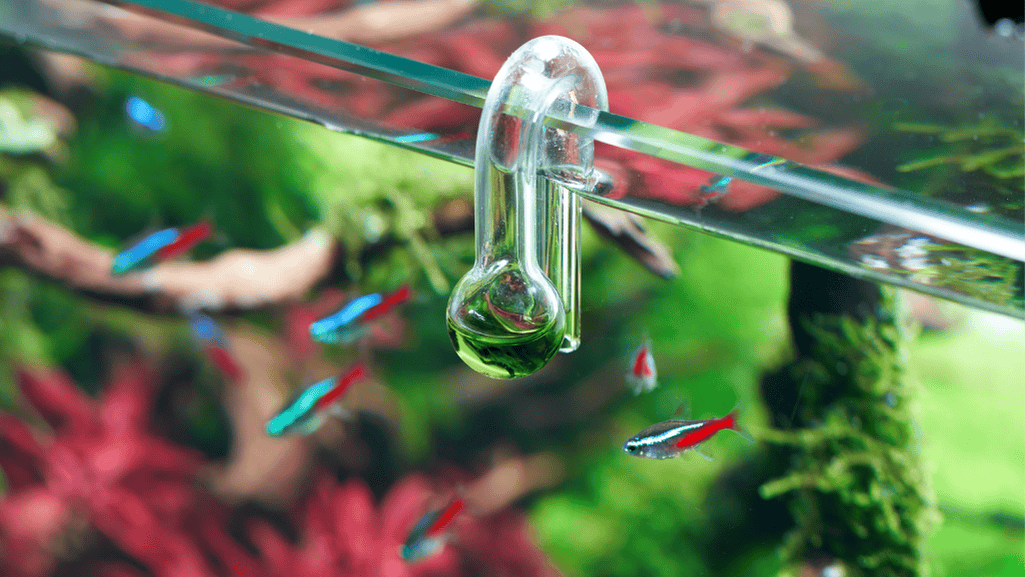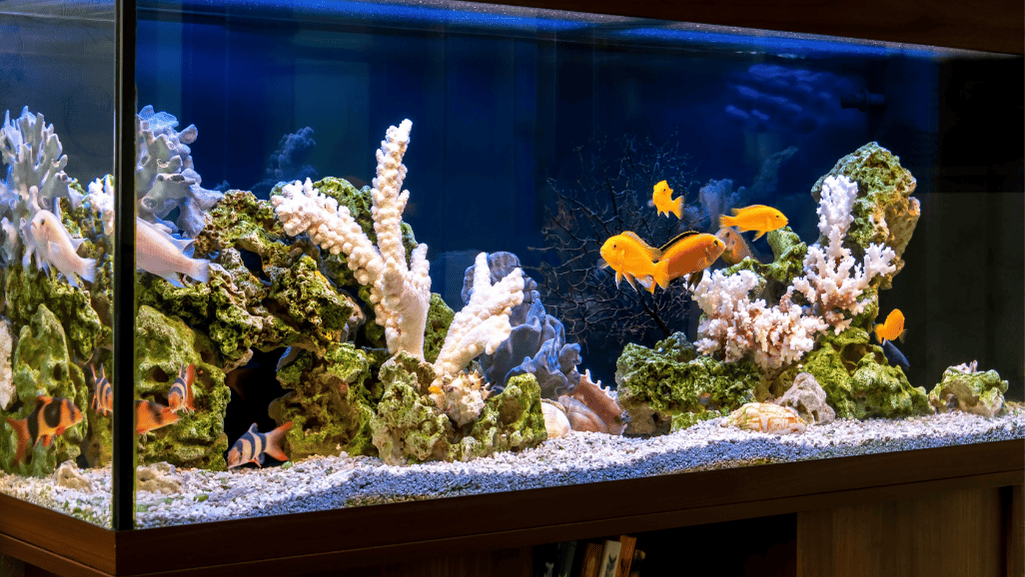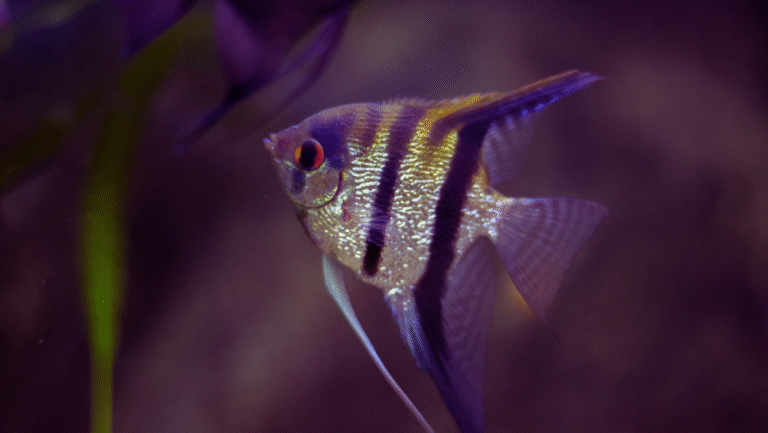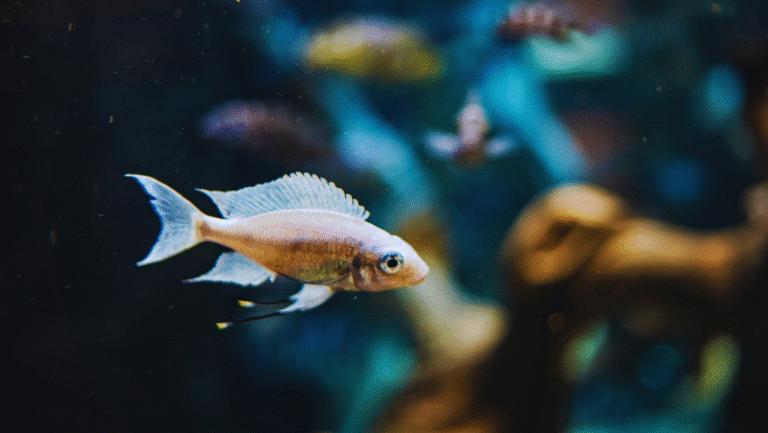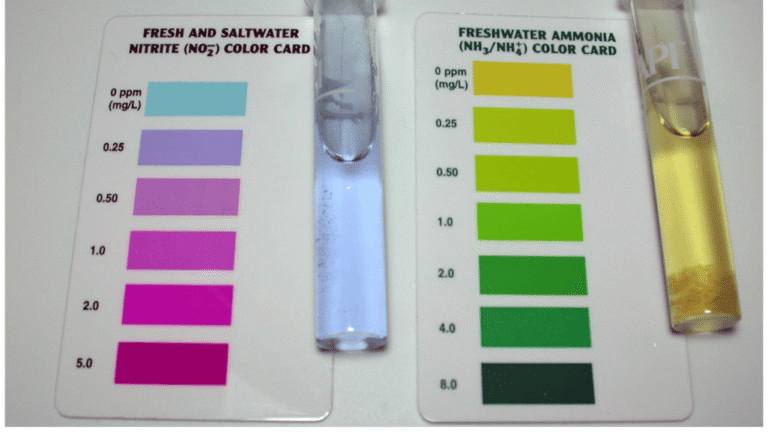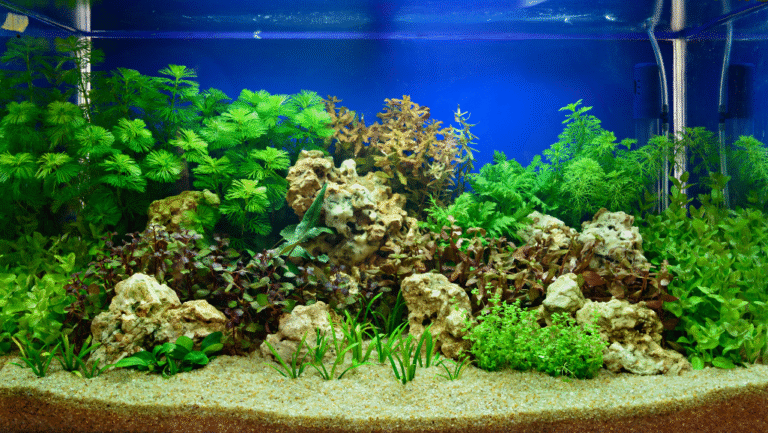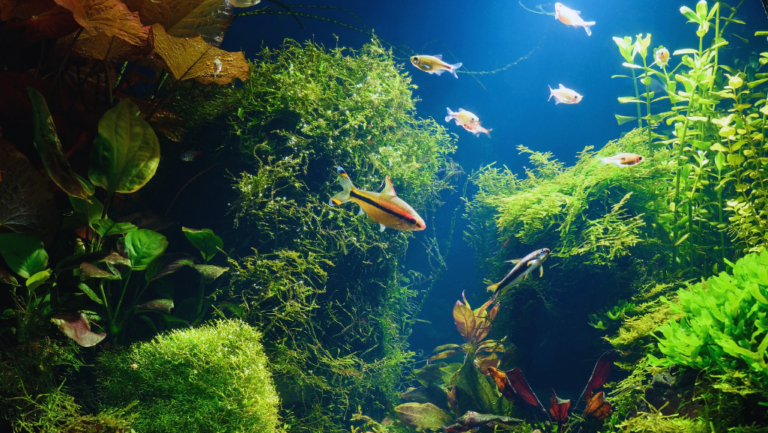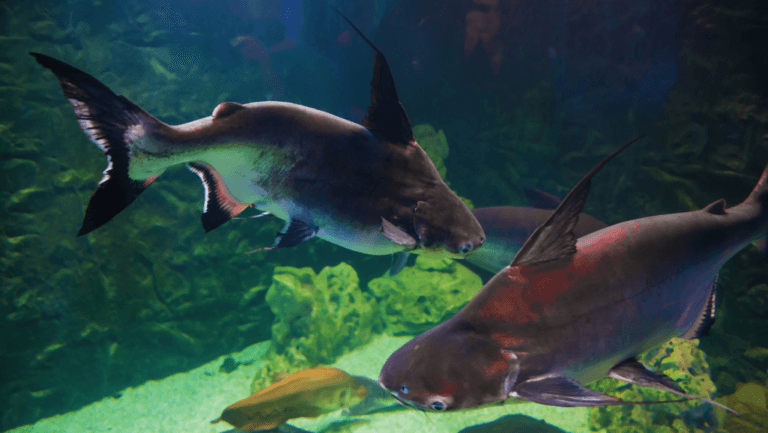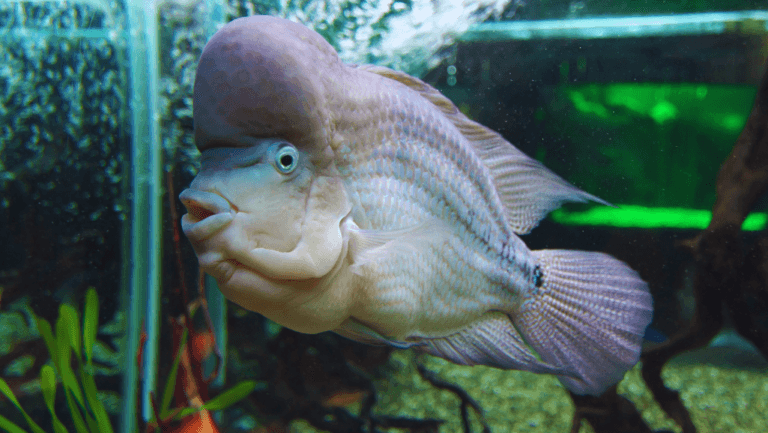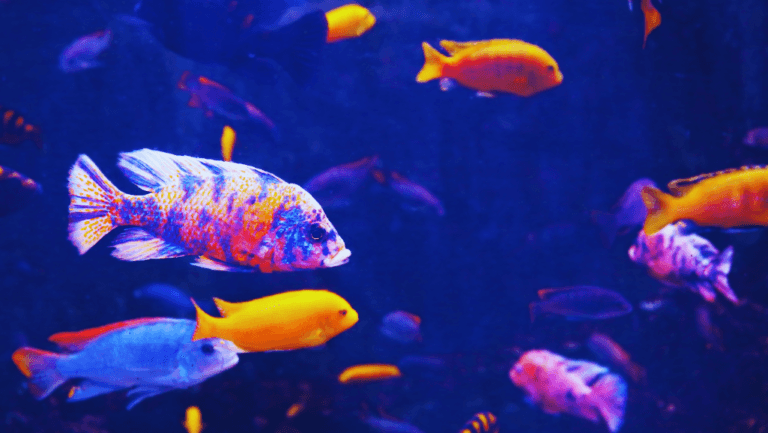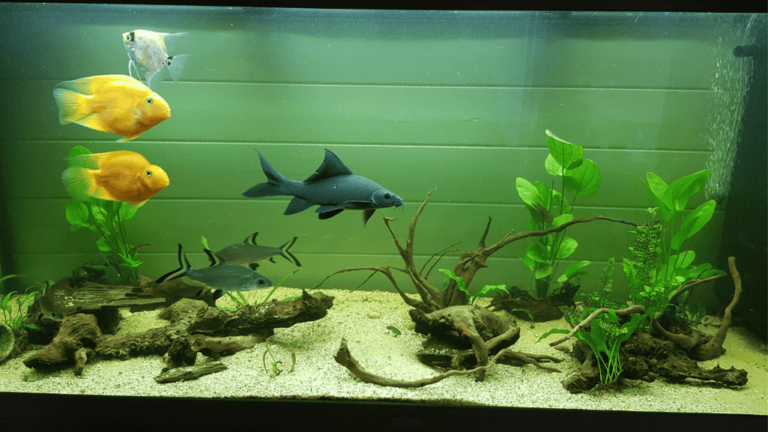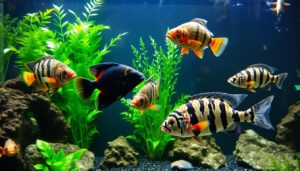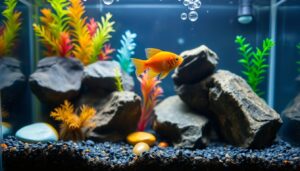Aquarium lovers know it’s both art and science to create a thriving underwater world. At the center of this balance is carbon dioxide (CO2), key for lush plant growth. Aquarium CO2 systems have changed how we care for planted aquariums, helping plants thrive and making our tanks look amazing.
Planted aquarium CO2 setups are now popular among hobbyists. They use pressurized CO2 systems to give plants what they need for photosynthesis. This results in faster growth, better colors, and healthier plants.
CO2 injection systems do more than just help plants grow. They keep pH levels stable, cut down algae, and balance the ecosystem for fish and other sea creatures. With the right setup and care, these systems can turn a simple tank into a vibrant underwater garden.
Key Takeaways
- CO2 systems significantly boost plant health and growth in aquariums
- Pressurized CO2 setups provide essential carbon for photosynthesis
- Proper CO2 levels help maintain pH balance and reduce algae growth
- CO2 injection systems can dramatically improve plant coloration
- Regular monitoring and maintenance are crucial for optimal CO2 system performance
Understanding the Role of CO2 in Planted Aquariums
CO2 is vital for planted aquariums. It fuels plant growth and makes underwater worlds thrive. Let’s see how CO2 affects aquarium plants and why it’s key for a successful setup.
The Science Behind Photosynthesis in Aquatic Plants
Aquatic plants need photosynthesis to grow. This process uses light, water, and CO2. In aquariums, CO2 is often the main limit for plant growth. With enough CO2, plants grow faster and show more color.
Natural CO2 Sources in Aquariums
Aquariums get CO2 from natural sources. These include gas exchange at the surface and fish breathing. Spring water can also have lots of CO2. Some plants grow well in areas with lots of CO2.
Benefits of Supplemental CO2 for Plant Growth
Adding CO2 to aquariums has many benefits. High-tech tanks with CO2 help plants grow faster than low-tech ones. Plants like red ones and carpeting types do best with extra CO2. The right CO2, light, and nutrients help plants thrive.
| Aspect | Low-Tech Tank | High-Tech Tank |
|---|---|---|
| CO2 Levels | 2-3 ppm (natural) | 20-30 ppm (injected) |
| Plant Growth Rate | Slower | Faster |
| Suitable Plant Types | Low-light, hardy species | Red plants, carpeting varieties |
| Maintenance | Lower | Higher |
Knowing how CO2 works in planted aquariums is crucial. It helps create lush, vibrant underwater spaces. By controlling CO2, aquarists can grow healthy plants and balance their ecosystems.
Types of Aquarium CO2 Systems
Aquarium fans have many CO2 system choices to help plants grow. You can pick from pressurized, DIY, or liquid CO2 options. Each has its own good points and downsides, fitting different tank sizes and upkeep needs.
Pressurized CO2 systems are top picks for serious plant tank fans. They use CO2 cylinders, regulators, and diffusers for exact control. They cost more at first but save money in the long run with cheap refills.
DIY CO2 systems are a cheaper option. They make CO2 from items like sugar, yeast, and water. Though not as reliable as pressurized systems, they work well for small tanks.
Liquid CO2 products are easy to use. Just add them to the water. But, they might not be as good as gas-based methods for plant growth.
| CO2 System Type | Pros | Cons | Best For |
|---|---|---|---|
| Pressurized CO2 | Precise control, efficient | Higher upfront cost | Large tanks, serious hobbyists |
| DIY CO2 | Cost-effective, easy to set up | Less reliable, requires frequent maintenance | Small tanks, budget-conscious owners |
| Liquid CO2 | Simple to use, no equipment needed | Less effective than gas-based systems | Nano tanks, beginners |
For nano tanks, ceramic diffusers are best for spreading CO2 evenly. In-line diffusers work well for small tanks with canister filters. No matter the system, keeping CO2 levels right is key for healthy plants and a balanced tank.
Components of a Pressurized CO2 System
A pressurized CO2 system is crucial for boosting plant growth in your aquarium. Let’s explore the key parts of this system.
CO2 Cylinders and Regulators
CO2 cylinders hold the gas that feeds your plants. These cylinders come in various sizes. A 5lb tank can last 3-4 months for a 40-gallon aquarium. CO2 regulators manage the gas flow, ensuring a steady supply to your tank.
Bubble Counters and Diffusers
Bubble counters measure CO2 flow. Aim for one bubble per second for every 20 gallons. CO2 diffusers release tiny bubbles into the water, helping plants absorb more CO2. The Precision SS-Series Stainless Steel Bubble Counter Kit is a favorite among aquarists.
CO2-Resistant Tubing and Check Valves
CO2-resistant tubing prevents gas leaks. Check valves stop water from flowing back into your system. Together, they keep CO2 levels steady, vital for plant health and preventing algae.
“Properly setting up a CO2 system ensures a healthy and vibrant aquarium.”
Keeping CO2 levels between 20-35ppm is best for most planted tanks. Use a drop checker kit to monitor levels and keep your underwater garden thriving.
Setting Up Your CO2 System: A Step-by-Step Guide

Adding a CO2 system to your aquarium can really help your plants grow. This guide will help you set up your CO2 system. You’ll learn how to do it right for great results.
First, pick the right gear. For tanks under 30 gallons, a 20oz paintball tank is good. Bigger tanks need a 5lb CO2 tank. Make sure to choose a reliable regulator, like those from CO2Art.
- Connect the regulator to your CO2 cylinder, using Teflon tape for a secure seal.
- Attach the bubble counter and check valve to prevent water backflow.
- Install the diffuser at the base of your aquarium for optimal CO2 dissolution.
- Connect all components with CO2-resistant tubing.
- Set up a drop checker to monitor CO2 levels.
Adjust the CO2 flow with the needle valve. Start with one bubble per second. Then, adjust it based on your plants’ needs. Use a timer to turn on CO2 during light hours. Start 1-2 hours before lights on and stop 1 hour before lights off.
| Aquarium Size | Recommended CO2 Tank | Starting Bubble Rate |
|---|---|---|
| Up to 20 gallons | 2.5-5 lb cylinder | 1 bubble/second |
| 25-40 gallons | 5 lb cylinder | 1-2 bubbles/second |
| 55+ gallons | 10 lb cylinder | 2-3 bubbles/second |
Keep an eye on your plants and fish after setting up your CO2 system. Adjust the levels as needed. Aim for a CO2 concentration of 25-35 ppm. This is best for plant growth without stressing your fish.
Monitoring and Adjusting CO2 Levels
It’s important to watch CO2 levels in your aquarium. This is key for your plants and fish. You’ll need co2 drop checkers and ph controllers to keep things right.
Using Drop Checkers and pH Controllers
Co2 drop checkers are like glass reactors. They show you how much CO2 is in the water. They change color based on CO2 levels.
Dark blue means low CO2, and yellow means it’s too high. For the best plants, you want a green color. This means your CO2 levels are just right, at 25-35 ppm.
Ph controllers are more precise. They measure how acidic the water is. This tells you about CO2 levels.
When you add more CO2, the pH goes down. But remember, other things like rotting matter can also change pH.
Optimal CO2 Levels for Different Plant Species
Not all plants need the same amount of CO2. Most need 15-30 ppm. But high-light tanks might need more CO2 to stop algae.
Bigger tanks and those with lots of plants might need stronger CO2. This makes sure CO2 spreads evenly.
| Plant Type | Optimal CO2 Range (ppm) | Drop Checker Color |
|---|---|---|
| Low-light plants | 15-20 | Light green |
| Medium-light plants | 20-25 | Green |
| High-light plants | 25-30 | Dark green |
It’s crucial to check and adjust CO2 levels often. Watch how your plants and fish do. And always keep an eye on your drop checker color.
Too little CO2 slows down plant growth. Too much can hurt your fish and invertebrates. So, keep it just right.
The Impact of CO2 on Water Chemistry
CO2 is very important for aquarium water chemistry. It dissolves in water to form carbonic acid, which lowers the pH. This change is key for plant growth but needs careful watching to keep the environment balanced.
In planted tanks, KH (carbonate hardness) helps keep pH stable. Tanks with low KH can have quick pH changes. These changes can stress fish and plants. The right CO2 levels help keep pH stable, making a great home for aquatic life.
It’s crucial to watch CO2 levels for good water chemistry. A CO2 indicator or test kit can help keep fish healthy. Too much CO2 can harm fish, while too little can slow plant growth.
| CO2 Level | pH Change | Plant Growth | Fish Health |
|---|---|---|---|
| Low | Minimal | Slow | Normal |
| Optimal | Moderate | Vigorous | Good |
| High | Significant | Rapid | Stressed |
Timing CO2 injection right is key to avoid pH problems. Running CO2 when lights are on keeps pH stable all day. This balance is essential for a healthy planted tank, where plants grow well and produce oxygen.
Balancing CO2, Light, and Nutrients for Optimal Plant Growth
To make your planted aquarium thrive, you need to balance CO2, light, and nutrients. This balance is crucial for healthy plant growth and avoiding algae.
The Importance of Proper Lighting
Lighting is key for plant photosynthesis in your aquarium. Most tropical plants need 12-14 hours of light each day. Using two full-length strip lights is a good idea for coverage.
Vita Lites and Philips Daylight bulbs are affordable and offer the right spectrum for plants.
Don’t forget to change your fluorescent bulbs every six months. This keeps the light strong. Good lighting is vital for aquarium plant health and growth.
Fertilization Strategies for CO2-Injected Tanks
CO2 injection helps plants grow faster, but they need more nutrients. Use aquarium plant fertilizers that have both macro and micronutrients. Iron is especially important for plants growing quickly under bright lights.
Here’s how to fertilize well:
- Change 25-30% of the water weekly to keep nutrients balanced
- Adjust fertilizers based on your tank’s conditions and plant types
- Watch and adjust nutrient levels to stop algae
| Factor | Importance | Recommendation |
|---|---|---|
| Light | Essential | 12-14 hours daily |
| CO2 | Beneficial | Supplement for fast growth |
| Nutrients | Critical | Regular fertilization |
Adjusting light, CO2, and nutrients carefully will help your plants grow well. This also helps keep algae away from your aquarium.
CO2 and Algae Control in Planted Aquariums
CO2 levels are key for keeping algae under control and for maintaining a planted tank. In high-tech setups, plants need more CO2 than the 2-3 ppm found in low-tech tanks. This extra CO2 helps plants grow well, competing with algae for nutrients and light.
It’s important to balance CO2 levels for good algae control. Too little CO2 can upset the tank’s balance, harming plants and letting algae grow too much. Too much CO2 can be bad for fish, making them gasp or even suffocate.
CO2 injection makes the water slightly acidic, which algae don’t like. This acidity, along with plants taking more nutrients, stops algae from growing too much. Regular care, like pruning and changing the water, also helps keep algae in check in CO2-injected tanks.
“CO2 injection is a crucial method for combating algae in planted tanks by aiding plant growth and helping establish a balance to prevent algae from taking over.”
To keep things right, use a CO2 test kit to check levels and adjust them if needed. While products and UV sterilizers can kill algae, they don’t stop it from coming back. A good CO2 system, along with the right lighting and fertilizers, is essential for keeping algae away and plants healthy.
Safety Considerations When Using Aquarium CO2 Systems
Aquarium CO2 safety is key for your fish’s health. CO2 systems help plants grow but can be risky if not used right. Here are important steps to avoid CO2 overdose and fish stress.
Avoiding CO2 Overdose and Fish Stress
Too much CO2 can harm fish, making them gasp or suffocate. Use a drop checker to check CO2 levels. Keep it between 25-35 parts per million (ppm) in your tank. Watch for signs of stress in your fish, like fast gill movement or odd behavior.
Use a timer to control CO2 injection. This keeps levels steady and stops buildup at night when plants don’t need CO2. For big tanks over 30 gallons, a 5lb CO2 tank is best. Smaller tanks can use a 20oz paintball tank.
Proper Equipment Maintenance and Checks
Regular upkeep is crucial for aquarium CO2 safety. Look for leaks, replace old parts, and make sure regulators and diffusers work right. Also, install a check valve to stop water from getting back into the CO2 system.
| Equipment | Maintenance Task | Frequency |
|---|---|---|
| CO2 Regulator | Check for leaks, adjust pressure | Weekly |
| Diffuser | Clean ceramic plate | Monthly |
| Tubing | Inspect for cracks or damage | Monthly |
| Check Valve | Verify functionality | Quarterly |
By sticking to these safety tips, you can enjoy your CO2 system while keeping your fish healthy and happy.
Comparing High-Tech and Low-Tech Planted Aquariums
Aquarists have to choose between high-tech and low-tech planted tanks. Each has its own benefits and challenges, especially with co2 injection vs natural methods.
High-tech aquariums use advanced gear like intense LED lights and CO2 systems. These setups can make plants grow 30% faster than usual. About 60% of aquarists who want to grow demanding plants choose these systems.
Low-tech tanks use natural CO2 and moderate lights. They’re great for beginners, with 70% of plant sales being slow-growing. These setups are close to nature, appealing to 80% of aquarists who like simplicity.
| Feature | High-Tech Aquariums | Low-Tech Planted Tanks |
|---|---|---|
| Monthly Cost | $50-$100 | $10-$20 |
| Water Changes | Bi-weekly | Monthly |
| Plant Diversity | 20% higher | Limited variety |
| Maintenance Level | High | Low |
| Growth Rate | Rapid | Slow |
High-tech setups grow plants faster and offer more variety. But, they need more time and effort. Low-tech tanks are better for those who want a natural, easy-to-care-for aquarium.
Troubleshooting Common CO2 System Issues
Fixing CO2 system problems is key to a healthy planted tank. These issues can harm plant health and tank balance. Let’s look at some common problems and how to solve them.
One big issue is when CO2 levels are not steady. Leaks in the system can cause this. For example, silicone tubing can lose up to 30% of CO2. Using polyurethane tubing can cut down on CO2 loss and make cylinders last longer.
Keeping your CO2 equipment in good shape is important. Check diffusers, bubble counters, and regulators often. Clean or replace diffusers to keep things running smoothly. If plants look like they’re not getting enough CO2, look for leaks or problems in the system.
It’s also important to balance CO2 with light and nutrients. The best CO2 level for plants is about 30ppm. Adding more CO2 without adjusting nutrients can cause problems. Be careful when you increase light, as it can make it harder to keep the tank balanced.
- Check for leaks in tubing and connections
- Clean or replace diffusers regularly
- Monitor CO2 levels with drop checkers
- Adjust CO2 in relation to light and nutrients
By fixing these common CO2 system problems and keeping your equipment in check, you can have a thriving planted aquarium.
Conclusion
Aquarium CO2 systems are great for making planted tanks look amazing. They help plants grow well, look more colorful, and make the tank a lively place. CO2 is key for plants to make food from sunlight and take in nutrients.
It’s important to keep CO2 levels right. Tools like drop checkers help keep CO2 below 30 mg/l, which is safe for fish. Placing diffusers and pumps right helps spread CO2 evenly, especially in big or very green tanks.
Getting a CO2 system might cost some money at first and needs upkeep. But, the benefits are worth it. The right mix of CO2, light, and nutrients makes a healthy space for plants and fish. You can choose a simple or advanced setup, but knowing how to manage CO2 is essential for a beautiful tank.
In short, CO2 systems are crucial for a successful planted tank. With the right CO2 levels, you can make your tank a stunning place. It will be full of healthy plants and happy fish.

